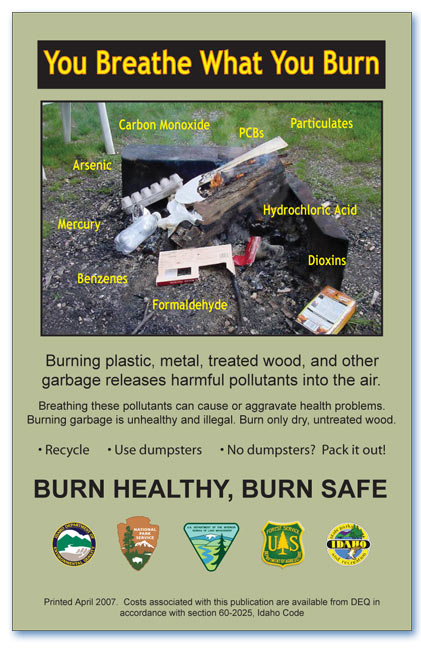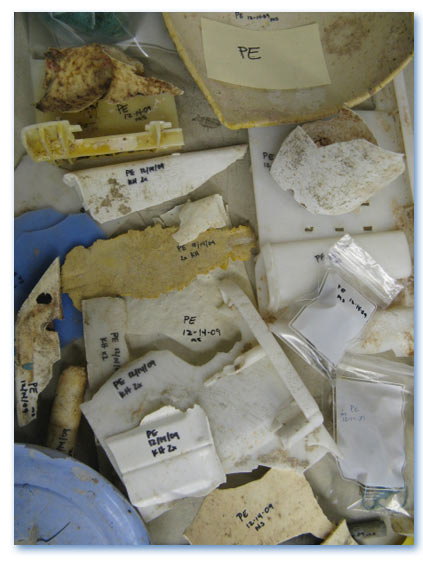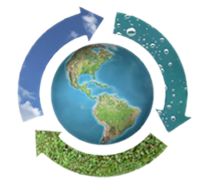Outside The Box
Investigation Into Plastic
By Melanie Smith
Plastic has revolutionized our world with its light weight and ability to be formed into multiple uses. Replacing wood, glass and metal packaging with plastic has economized transportation costs around the world, allowed us to develop products that would not have been feasible without its use, improved medical equipment and safety, increased product freshness in many markets including food, According to the American Chemical Counsel 69%of plastic is made from natural gas, 24% is made from crude oil and the balance of 7% comes from other sources including plant sources.
There are two types of plastics: thermoplastics and thermosets. Thermoplastics will soften and melt if enough heat is applied; examples are polyethylene, polystyrene, polyvinyl chloride and polytetrafluoroethylene (PTFE). Thermosets can melt and take shape once; after they have solidified, they stay solid.
The plastic industry has classified the most commonly used plastic into seven different categories according to their chemical makeup. Each number represents the type of resin used to produce the plastic. These classifications are mostly used for recycling purposes, as each resin type melts at a different temperature and displays different properties. To assist recycling of disposable items, the Plastic Bottle Institute of the Society of the Plastics Industry developed its resin identification coding system in 1988. A plastic container using this scheme is marked with a triangle of three cyclic arrows, which encloses a number giving the plastic type:

The symbol with the three arrows does not necessarily mean that it is recyclable, that is a misunderstanding for many. Most municipal recycling collection only take #1 and 2 while a few facilities take #4 and 5..Number 1 and 2 plastics are mostly purchased by overseas exporters that ship the sorted bales or bulk mixed material out of the US. Plastic film is recyclable at drop location in supermarkets and is very efficiently recycled into decking in the US.
What Floats
The plastic types known to float (have a specific density lighter than water) are HDPE (2), PP (4), Polystyrene (5) and some types of 7 including nylon (PU). Other plastic will float if formed with an air pocket or if attached to another floating type of plastic. We have seen examples of this in the North Pacific Gyre with a PVC fishing float that was hollow inside or fragments of a PET bottle still screwed to a PP cap.

Plastic Toxicity
Due to their insolubility in water and relative chemical inertness, pure plastics generally have low toxicity in their finished state, and will pass through the digestive system with no ill effect (other than mechanical damage or obstruction). This is statement is argued by many but read on.
However, plastics often contain a variety of toxic additives. While the finished plastic may be non-toxic, the chemicals used in its manufacture may be toxic; and small amounts of those chemical may remain trapped in the product. For example, plasticizers like adipates and phthalates are often added to brittle plastics like polyvinyl chloride (PVC) to make them pliable enough for use in food packaging, children’s toys and teethers, tubing, shower curtains and other items. Traces of these chemicals can leach out of the plastic when it comes into contact with food. The World Health Organization’s International Agency for Research on Cancer (IARC) has recognized the chemical used to make PVC, vinyl chloride, as a known human carcinogen. Out of these concerns, the European Union has banned the use of DEHP (di-2-ethylhexyl phthalate), the most widely used plasticizer in PVC. Some compounds leaching from polystyrene food containers have been found to interfere with hormone functions and are suspected human carcinogens.
The primary building block of polycarbonates, bisphenol A (BPA), is an estrogen-like hormone disrupter that may leach into food and drinks and is found in hard plastic water bottles such as the 5 gallon water cooler bottles. Research in Environmental Health Perspectives finds that BPA leached from the lining of tin cans, dental sealants and polycarbonate bottles can increase body weight of lab animals’ offspring. A more recent animal study suggests that even low-level exposure to BPA results in insulin resistance, which can lead to inflammation and heart disease.
A Note About Dioxins
Dioxins occur as by-products in the manufacture of organochlorides, in the incineration of chlorine-containing substances such as PVC (polyvinyl chloride), in the bleaching of paper, and from natural sources such as volcanoes and forest fires. Occupational exposure is an issue for some in the chemical industry, or in the application of chemicals, notably herbicides. Dioxins are produced in small concentrations when organic material is burned in the presence of chlorine. Who is responsible? Waste incinerators, commercial facilities and individuals (combusting garbage) are primarily responsible for the dispersion of these toxins. Dioxins are produced primarily through the combustion of chlorine-based materials such as PVC plastic, chlorinated solvents and pesticides. The incineration of these products spews deadly dioxin into the atmosphere where it is transported long distances, settling on plants and imbedding itself into soil and water sediment. Because these compounds decompose very slowly, they lay in wait to be consumed and spread throughout the food chain. Dioxins enter the general population almost exclusively from ingestion of food, specifically through the consumption of fish, meat, and dairy products since dioxins are fat-soluble and readily climb the food chain.

When the original US EPA inventory of dioxin sources was done in 1987, incineration represented over 80% of known dioxin sources. As a result, US EPA implemented new emissions requirements. These regulations have been very successful in reducing dioxin stack emissions from incinerators. Dioxins are also generated in reactions that do not involve burning — such as bleaching fibers for paper or textiles, and in the manufacture of chlorinated phenols, particularly when reaction temperature is not well controlled. Affected compounds include the wood preservative pentachlorophenol, and also herbicides. Dioxins are present in minuscule amounts in a wide range of materials used by humans — including practically all substances manufactured using plastics, resins, or bleaches. Such materials include tampons, and a wide variety of food packaging substances. The use of these materials means that all Western humans receive at least a very small daily dose of dioxin. Dioxins are absorbed primarily through dietary intake of fat, as this is where they accumulate in animals and humans. In humans, the highly chlorinated dioxins are stored in fatty tissues over time (bioaccumulate), so even small exposures may eventually reach dangerous levels and are neither readily metabolized nor excreted. The estimated elimination half-life for highly chlorinated dioxins (4-8 chlorine atoms) in humans ranges from 7.8 to 132 years.
POPs or Perpetual Organic Pollutants
There is a growing body of confirmed data that reveals the ability of plastic in the ocean to gather and accumulate POPs to its surface. These POPs accumulate on the ocean born plastic particles and get carried into the food chain as marine organisms, mistaking the particles for food, ingest the plastic. The POPs concentrate and travel up the food chain to marine life that ultimately ends up in the human food system concentrating up to 1000 fold. AS the POPs concentrate there is a great enough load of toxins that we are seeing the effect on whale populations and in quantities toxic to humans.
